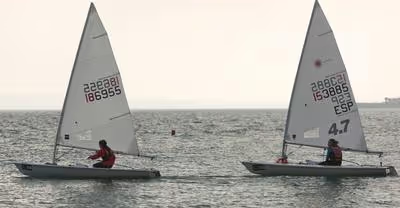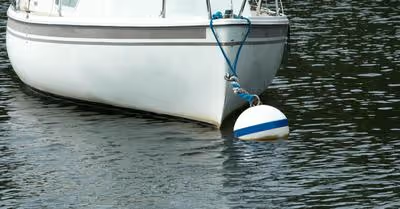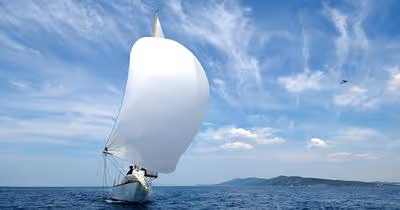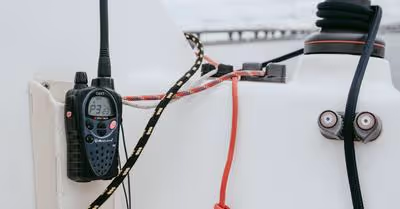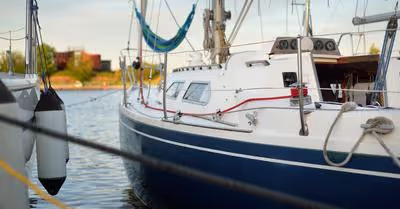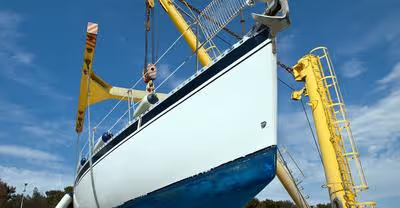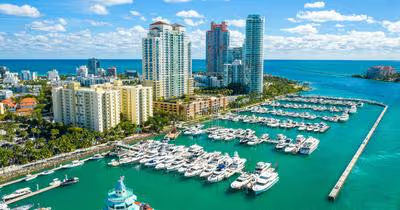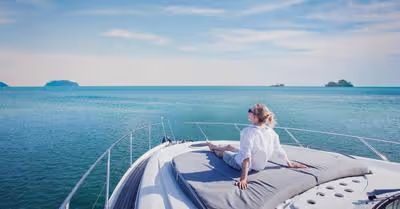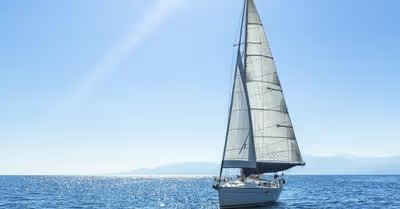Table of Contents
Best Sailboats for Beginners
When it comes to choosing the right sailboat for you, there is no such thing as a one-size-fits-all solution. There are various distinct sorts to pick from, each with its own peculiarities and advantages. Buying a sailboat is a major investment, so it's important to test one out at least once before making a decision. Hopefully, the following section will help you see all of the options available to you, making your decision a little easier:
Dinghies
For true beginners, dinghies are an excellent choice. When you think of "tiny sailboats," they're probably what comes to mind. Dinghies are one- or two-person sailboats with a single sail and a single mast that are meant to be easy to use. They are perfect for learning with an instructor and practicing on your own because they are designed for one or two individuals. They are incredibly light, which makes them convenient to use but also makes them prone to capsizing. If the boat capsizes, you will most likely be able to simply correct it because they're so light. They are primarily made of plastic and are inexpensive and durable, making them ideal for beginners.
Types of Dinghies
Hartley 10 Dinghy
This dinghy is ideal for novices because it is simple to control. It comes with a single sail and is quite maneuverable and forgiving on the water, so you won't be swimming for long periods of time. It's also simple to sort in the event of a capsize, and its weight makes it easy to manage on the beach. Another evident advantage for novices is that the dinghy was created with them in mind.
Laser Pico Dinghy
Another entry-level boat that deserves to be included in the finest dinghies for beginners list. It's wonderful to learn on, with a high boom and a large cockpit and is used by sailing schools all around the world. This boat comes with all the whistles and bells you'd expect on a modern dinghy when you buy it.
The Traveler
This dinghy is ideal for beginners, as it is built to withstand even the shallowest of waters. It's a straightforward, high-quality boat that's suitable for even the most seasoned sailors. This dinghy is frequently used as a racing dinghy, which means it is speedy, nimble, and easy to use. This model may cost around $15k, but it is still a decent choice for a boat if you are a more experienced sailor.
The GP14
It won the 2016 World Sailing Championships in Barbados, so you know you're getting a good boat. Depending on the condition and age, it is only going to cost you around $1,000 or $3,000.
Small Sloops
This sailboat may accommodate up to four passengers, though 1-2 is optimal. It is slightly larger than a dinghy; it still usually has only one mast, but it can have one to three sails. They are frequently equipped with cleats rather than winches, making them simple to operate for beginners. Sloops come in a wide range of sizes, so you should think carefully about which one is right for you. If this is your first boat, smaller is better. If you've sailed in a dinghy before and are confident, a larger sloop might not be the worst choice.
Catalina 27
This option is for individuals who are more certain of themselves and their choices. The Catalina 27 is a dependable sloop that is ideal for novices. Depending on the condition of the boat, it can cost anywhere from $4k to $20k. This is an older model from the 1990s, but it is solid and durable. This could be the boat for you if you can find one at a reasonable price.
The Skipper Craft SC-200
The skipper is a small, antique sailboat that is relatively inexpensive. It's a straightforward boat that's ideal for learning. If you damage this boat, you are unlikely to entirely destroy it, and repairs will be inexpensive. One can be had for as low as $2,000. Anyone who does not want to break the bank, but spend a lot of time on the boat should purchase this sailing boat.
Catamarans
Catamarans are ideal for novices. They are by far the most dependable option, although they are quite pricey. Since there are two hulls in a catamaran, it is often wider. As a result, your chances of capsizing are quite slim. They are also swift since they are light and nimble. They are also sometimes equipped with trampoline seating rather than a solid deck. Catamarans usually have one mast, one or two sails, and are steered by the tiller. If you are willing to pay a bit extra money, this may be the best option for you.
Types of Catamarans
Manta 42
The Manta 42 is a traditional multihull catamaran that was produced in Florida in the late 1990s and early 2000s. It is distinguished by its high bows and curved crossbeam, which were designed by French naval architect Eric Lerouge. A Manta 42 is a relatively light boat with plenty of capacity for extras like solar panels and dinghies.
Dolphin 42
The Dolphin 42, built in Brazil, has a daggerboard for added stability and the potential to aim higher. This also allows you to anchor in shallower water by reducing the quantity of wetted surface. The Dolphin 42 also includes a foam core, which means it's lighter and less likely to get wet. This ship also includes a refrigerator, as well as hot water, air conditioning, a TV, and a computer built-in.
Dart 18
The Dart 18 is a beginner-friendly catamaran constructed in the United Kingdom. It is extremely huge and thus very sturdy, making it ideal for solitary trips. This type is a little harder to come by, but you can get one for around $7k, which isn't cheap considering how fast and dependable this boat is.
Sprint 15
Another British catamaran, though this one is a little slower. This is the most common catamaran in the United Kingdom, and it is considerably easier to locate in the United States. It's a double-handed catamaran, so you may need to tailor your sailing style to the catamaran's requirements; once that's done, it'll be smooth sailing. This model is perfect for beginners and costs around $2,000 only.
What motivates people to learn to sail?
Sailing is learned for a variety of reasons. Many individuals do it for the opportunity to travel, others do it because they enjoy being on a boat, and of course for sailing competitions. Whatever category you fall into, or even if you create your own, there are certain universal benefits of learning to sail.
Learning to sail is a practical skill that can lead to a variety of new occupations and career opportunities that you may not have considered previously.
Sailing has also been demonstrated to improve teamwork abilities, decision-making, and critical thinking skills. It is ideal for people of all ages, especially youngsters.There are numerous benefits of learning to sail as a hobby if you’re considering buying a sailboat for beginners.
These advantages should not be overlooked, whether you are learning to sail for these reasons or simply as a bonus. Unfortunately, many rookie sailors don’t consider the following benefits while purchasing their first sailboat. If you're on the fence about sailing, these advantages should persuade you that it's well worth the investment:
Freedom
Sailing gives you a sensation of freedom that you've probably never experienced before. It is impossible to travel the world without being able to go at any time (with the correct weather conditions). If you've never been on a sailboat before, you might not realize how unique an experience it is. This should, in fact, motivate you to push yourself even more to learn how to sail.
Community
Sailors typically belong to a close-knit community and are well-connected with each other. Whether it's through a yacht club, sailing contests, or your local marina, there's something for everyone. Sailors are like-minded individuals who value the water, their boats, and the activity of sailing.
Competition
Sailing competitions are fierce and thrilling. It's a true test of talent and determination. Sailing events are something you don't want to miss, whether you're competing or just watching. It doesn't have to be a big event like the transatlantic race; it may just be a monthly competition at your local club.
History
Sailing can help you feel connected to your ancestors and history. After all, sailing is an old culture that has played such an important role in shaping the world we live in today. Britain, France, Spain, Holland, the Romans, the Vikings, and other historically prominent peoples and countries all based their empires on their dominance of the seas, whether through commerce or naval warfare.
Common Issues for Beginner Sailors
When learning to sail, many novices experience certain difficulties. After all, sailing is a difficult sport. Even for individuals who grew up around sailboats and have sailing parents, learning to sail can be difficult. Few other pastimes necessitate such knowledge, talent, respect, and instincts as sailing.
Here are some of the most typical challenges that novice sailors face, so you'll be aware of them and well-prepared before they start bothering you.
Understanding the jargon
It can be challenging to learn the vocabulary and common sailing lingo. If you grew up around boats, you may have picked up on a lot of this information. It can feel like learning a new dialect if you haven't done so. A lot of boat communication is about relaying important information and precise instructions. One of the hardest aspects of learning to sail is learning how to speak like a sailor (without cursing).
Laws
Learning maritime regulations and road restrictions is a crucial component of being a sailor. You must learn the regulations of the sea, just as you must learn the rules of the road while learning to drive a car.This is both a legal and a safety need. It's critical to understand who has the right of way, how to ask for help, and how and when to assist others.
Tying knots
If you didn't grow up in the sailing clubs or boy scouts, there's a slim chance you know how to tie a knot. That's fine; everyone must begin at the beginning. It does mean that tying all of these complicated knots you've never seen before could be difficult. You'll also need to memorize all of the names. This may appear to be a hassle, but it is an essential element of being a sailor. Every knot plays an important role, and they must all be tied in the same way, or the person attempting to untie them will get themselves into difficulty.
What to look for in sailboats
While there are many various types of sailboats to choose from, there are several characteristics of a sailboat that make it easier to handle for a beginner. Professional sailboats are extremely sophisticated, and only the most experienced sailing teams are capable of handling them. Learning to sail will be much easier if you choose a beginner-friendly sailor boat.You will eliminate many of the factors to consider if you learn on a simpler boat; thus, allowing you to focus on the fundamentals. Don't worry; in no time at all, you'll be ready for the larger, more magnificent sailboats. When buying your first sailing boat, check for the following features:
Tiller control
No-wheel tiller steering is an excellent approach to get a feel for how your boat handles. Since the tiller is directly connected to the rudder, you may get immediate feedback on your boat's speed, direction, and wind influence. When steering with a wheel, there is a latency, and you don't feel the rudder directly. This is an excellent technique to learn to feel the boat's movements. It will be much easier to steer your boat if you have an instinctive connection with it.
Winches
Having cleats instead of winches on your new sailboat can make your life so much easier. They are easier to handle, withstand heavy winds with less force, and are great for novices, whether young or old. Smaller boats may come standard with winches, but this isn't always the case. A key issue to ask the vendor is whether your yacht has winches to manage the sheets and halyards or cleats.
Size
Your sailboat will be easier to handle if it is smaller. A bigger boat may be steadier, but it is also more difficult to steer. When learning to sail, you want as little to worry about as possible. You'll be preoccupied with so many other issues that you won't have time to consider everything included in a larger yacht. You can raise the size of your yacht as your skills grow. You will be able to respond immediately after you have a solid grasp on everything associated with a smaller boat. This will enable learning the new features of your larger boat much simpler.
Sturdiness
You should purchase a boat that is as strong as possible. The more lenient you are, the better. It's unavoidable for you to make blunders. Having a sailboat that can handle all of the knocks and bumps you'll undoubtedly give it will save you a lot of problems and misery. Getting a Rotomolded boat is the best option. Rotomold is a tough plastic that, while not as attractive as finished wood or even fiberglass, will last considerably longer. It's also a lot less expensive, making it ideal for a beginner sailboat.
Recent Articles



